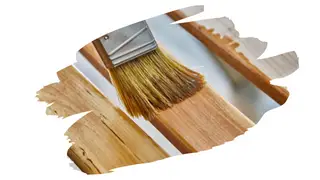Polycrylic is a quick-drying wood finish that’s incredibly easy to apply. This interior sealer not only makes wood more water-resistant, it can also safeguard it from scratches and scrapes.
But, when it comes to wood finishing, we don’t merely want to protect wood — we also want it to look good. And a big part of making sure that happens is by using the right method of application.
So, if you want to quickly apply a brush-on Polycrylic — for a streak-free finish — what’s the best brush for the job?
Well, in this post you’ll learn why applying Polycrylic with a brush is better than using a foam brush. You will also learn why ‘raising the grain’ could be key to getting a smooth final coat.
And keep reading to discover the best way to apply a streak-free Polycrylic finish — without using a brush…

This post may contain affiliate links to products that we receive a commission for (at no additional cost to you). Learn more here.
What’s The Best Way To Apply Polycrylic For A Smooth Finish?
Well, there are really three main things you need to do when applying this water-based finish;
1). Make Sure You Use A Synthetic Bristle Brush
Using a synthetic brush will minimize the chances of air bubbles becoming trapped in that finish.
That’s because a natural bristle brush can sometimes add little pockets of air to thick finishes.
2). Prepare The Brush Before You Apply
Dip that brush into clean water — then squeeze off the excess — before you dip it into the can of Polycrylic.
This helps to reduce the chances of the brush adding air bubbles to this wood sealer.
Related Post: Help! Why Are There Air Bubbles In My Polycrylic Finish! [+ What You Can Do To Fix It]
3). Raise The Grain Beforehand
Raising the grain, (sometimes called Popping the grain), is a key preparatory step when applying water-based finishes to wood.
Wait…Why Do You Need To Raise The Grain?
It’s because wood is an incredibly absorbent material.
Wood is classed as a hygroscopic material. Which means that it will fast-absorb water, moisture, and even water vapor from the air.
Now, when wood absorbs water, the fibers of wood swell up. And this in turn raises the grain, causing wood fibers to pop up.
And this is often what happens when you apply a water-based finish or sealer onto bare timber.
As a result, a water-based finish can leave behind a rough-feeling surface. Which is all thanks to the many little raised wood fibers poking up all throughout that finish.
In short, if you don’t raise the grain beforehand, then a water-based sealer will raise the grain for you.
Related Post: Can You Paint Over Polycrylic (All Without Sanding)?
OK. But Do You Have To Raise The Grain Before Applying Wood Sealer?
Generally, only with water-based finishes, such as Polycrylic. And only when applying it onto the surface of natural solid wood.
However, solvent-based finishes, (such as oil-based polyurethane), don’t have the same raised grain effect on wood.
Of course, raising the grain ahead of time only matters if you want as smooth a finish as possible. But, if you don’t mind the finish feeling coarse — like natural solid wood — then you don’t need to.
And you may not need to raise the grain if you plan on applying multiple coats of Polycrylic (three or more). That’s because sanding in-between each coat will do much of the work of smoothing away raised wood fibers anyway.
And Exactly How Do You Raise The Grain?
You can learn how to raise the grain by checking out our post here: Do You Really Need To Raise The Grain Before Applying Oil?
In that post we go into more detail about why water-based finishes can sometimes leave wood feeling rough. And we have a step-by-step guide to popping the grain before applying any finish.
Great! So Which Synthetic Brush Do You Recommend For Applying Polycrylic?
Ideally, you want a brush that makes it easy for you to leave behind a streak-free finish. Which is why Wooster Brush Company’s Shortcut Angle Sash Paintbrush is the perfect tool for the job.
Wooster’s have plenty of experience creating paintbrushes for every type of stain, finish or sealant imaginable. Especially since they’ve been manufacturing brushes, in Ohio USA, for well over a century.
Which is why their Shortcut Angle Sash Paintbrush has an innovative brush handle design.
With a handle shaped for easy-grip, their brush lets you comfortably maneuver around even the most awkward angle.
This allows you to achieve an effortless streak-free finish on difficult-to-coat corners and edges.
Can I Apply Polycrylic With a Foam Brush? You could, but it will leave behind a lot of trapped air bubbles in that sealer. So you are better off using a brush to apply this product.
But Brushes Leave So Many Streaks! How Do You Apply Polycrylic To Wood Without Streaks?
If you are concerned about streaking, then you can use a spray-on aerosol Polycrylic. This will allow you to apply Polycrylic without having to worry about streaks or air bubbles.
Also, spraying on this finish makes it even easier to get a more even coat.
However, its worth noting that any spray-on finish/sealer tends towards very thin application. So they can often require more coats, than if you simply brushed it on.
Related Post: Can You Put Polycrylic Over Chalk Paint? (How To Keep Chalk Paint From Scratching)
To Wrap Up, Here Are The 3 Key Takeaways From This Post…
- 1). Polycrylic is a water-based sealer. And water-based sealers can sometimes raise the grain of natural wood.
- 2). Use a synthetic bristle brush to apply Polycrylic. This type of brush-on application will minimize the chance of bubbles becoming trapped in the finish.
- 3). Alternatively, you can use a spray-on Polycrylic finish for a streak-free top coat.


![Help! Why Are There Air Bubbles In My Polycrylic Finish! [+ What You Can Do To Fix It] bubbles in polycrylic finish](https://www.thewoodworkplace.com/wp-content/uploads/2022/10/Banner-490-150x150.jpg)
